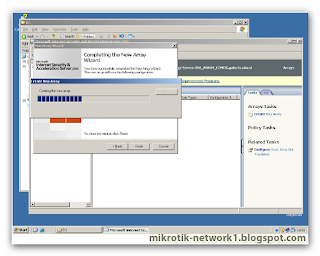Quoting Microsoft
ISA 2006 Array, Step by step configuration guide
ISA 2006 Array
Step by step configuration guide
Index
Preface. Step 1, Install Configuration Storage Server.
Step 2, Create an array.
Step 3, Install your ISA servers .
Step 4, Configure network objects .
Step 5, Finishing up and some notes .
Preface
This guide will guide you step by step in order to deploy an ISA 2006 array in AD
environment. It does not cover server publishing in any way. It just covers CSS, NLB
and VIP configuration to get the array up and running.
This guide will be based on a setup of five computers in a lab environment configured
as the exhibit below:
The environment consists of two network segments like:
Network A
IP: 10.42.43.0
Mask: 255.255.255.0
Router: 10.42.43.254
Network B
IP: 192.168.15.0
Mask: 255.255.255.0
Router: 192.168.15.254
Step 1, Install Configuration Storage Server
First we need to ensure that we have the CSS (Configuration Storage Server)
installed. This server will hold the configuration for the enterprise and this is where
the ISA servers will get their firewall configuration from.
The Configuration Storage server uses Active Directory Application Mode (ADAM) for
storage. When you install the CSS, you also automatically install ADAM on the
server.
The CSS may be one of the ISA servers, but my recommendation is to place this on
a separate server on the inside, in our case Network B. You may also install an
alternative CSS later on to be used as backup if the first CSS fails.
The communication between CSS and the ISA servers are done through MS Firewall
Storage protocol, which is based on LDAP, outbound TCP protocol on port 2171.
server or one of your ISA servers. Click Next
Click Next
chosen to deploy within workgroups or domains without trusts.
In the later case we would use certificates between the ISA servers and the CSS.
This, however, will require a CA server.
Click Next to finish up here
Step 2, Create an array
Let the installation progress now and when it´s ready open up the ISA Server
Management MMC and navigate to Array, rightclick and select New array
Type in the name for your new array and click Next
Type in the DNS name of the array to be used by Firewall Clients and click Next
Accept Default Policy and click Next
Specify what kind of firewall rules that will be available to this array and click Next
Let the installation progress now and when it´s ready open up the ISA Server
Management MMC
Navigate to Firewall Policy
Computers in the Network Objects tab under Toolbox
Apply the changes.
Step 3, Install your ISA servers
This step must be repeated for each of your ISA servers that will be working in the
array
This time we´ll choose to install just the ISA server services. Click Next
Enter the FQDN of the CSS or just browse the directory. Click Next
Management MMC
array into the Managed ISA Server Computers in the Network Objects tab under
Toolbox as seen in Step 3
Now the ISA server must join the array we created earlier. Click Next
Choose the array. In our example the name of the array is Skynet
Since the ISA server and the CSS belong to the same AD we´ll use Windows
authentication
Let the installation progress now and when it´s ready open up the ISA Server
Management MMC
Step 4, Configure network objects
Now NLB (Network Load Balancing) and VIP (Virtual IP) must be configured.
Navigate to Enterprise Networks
Navigate to Networks under your array configuration
Click Add Adapter and select the Internal interfaces for ALL your ISA servers
belonging to the array. Click OK all the way back to MMC main window.
Choose Enable Load Balancing Integration from the Tasks tab in the right section of
MMC and a wizard will start
Step 5, Finishing up and some notes
configuring systems like payment aso. These systems can be quite sensitive to
changes in the client session, especially if the session all of a sudden changes IP.
These sessions must then be configured as so called Sticky Sessions that will remain
the same as long as communication is established.
If you have this problem then disable CARP.
icons indicating that there are not problems. If you see small timers instead it´s just
because the CSS have not yet retrieved status information from your ISA servers.
To test the configuration using ICMP (ping) you might have to make some temporary
changes to the System Policy as seen below
A and kill one of the ISA servers. All you should notice is a few Request time out
before the surviving firewall takes over.

















































